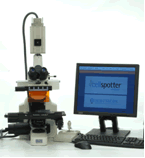


FDA
Home Page | CDRH Home Page | Search
| CDRH
A-Z Index | Contact CDRH
![]()
   |
| FDA
Home Page | CDRH Home Page | Search
| CDRH
A-Z Index | Contact CDRH
|
 |
 |
||||
CellSearch™ Epithelial Cell Kit / |
 |
Product Name: CellSearch™ Epithelial Cell Kit / CellSpotter™
Analyzer
Applicant: Veridex, LLC, A Johnson and Johnson company
Address: 1001 US HWY 202, Raritan, New Jersey 08869-0606
Clearance Date: January 21, 2004 (Approved Evaluation of Automatic
Class III Designation)
Clearance Letter: http://www.fda.gov/cdrh/pdf3/k031588.pdf
What is it? The CellSearch™ Epithelial Cell Kit / CellSpotter™ Analyzer are used on breast cancer patients to help determine the effectiveness of their cancer treatment.
The CellSearch™ Epithelial Cell Kit helps a medical professional find Circulating Tumor Cells (CTC) in a blood sample. The CTC are then counted by a pathologist with the aid of the CellSpotter™ Analyzer. The more CTC in the blood sample, the less effective the cancer treatment is.
How does it work?
When is it used? The CellSearch? ™ Epithelial Cell Kit / CellSpotter?™ Analyzer are used for patients undergoing treatment for breast cancer. The presence of CTC in the blood is associated with decreased survival in patients treated for spreading (metastatic) breast cancer.
What will it accomplish? The CellSearch™ Epithelial Cell Kit / CellSpotter™ Analyzer monitors breast cancer treatment and indicates its effectiveness.
When should it not be used? There are no contraindications for these devices.
Additional information:
General information about breast cancer, its diagnosis and treatments:
http://www.cancercare.org/BreastCancer/BreastCancermain.cfm
Breast cancer information from the American Cancer Society:
http://www.cancer.org/docroot/CRI/CRI_2x.asp?sitearea=LRN&dt=5
Updated May 4, 2004
![]()
CDRH Home Page | CDRH A-Z Index | Contact CDRH | Accessibility | Disclaimer
FDA Home Page | Search FDA Site | FDA A-Z Index | Contact FDA | HHS Home Page
Center for Devices and Radiological Health / CDRH